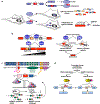Alternative splicing as a regulator of development and tissue identity
- PMID: 28488700
- PMCID: PMC6839889
- DOI: 10.1038/nrm.2017.27
Alternative splicing as a regulator of development and tissue identity
Abstract
Alternative splicing of eukaryotic transcripts is a mechanism that enables cells to generate vast protein diversity from a limited number of genes. The mechanisms and outcomes of alternative splicing of individual transcripts are relatively well understood, and recent efforts have been directed towards studying splicing networks. It has become apparent that coordinated splicing networks regulate tissue and organ development, and that alternative splicing has important physiological functions in different developmental processes in humans.
Conflict of interest statement
Competing interests
None
Figures



References
-
- Pan Q, Shai O, Lee LJ, Frey BJ & Blencowe BJ Deep surveying of alternative splicing complexity in the human transcriptome by high-throughput sequencing. Nat. Genet 40, 1413–1415 (2008). - PubMed
Publication types
MeSH terms
Substances
Grants and funding
LinkOut - more resources
Full Text Sources
Other Literature Sources

